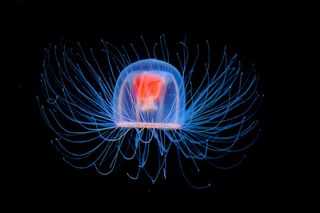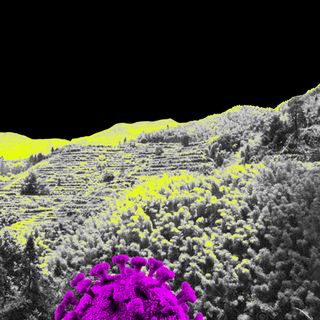
What Jellyfish Can Tell Us About Immortality
Emerging research is beginning to study a species of jellyfish for its regenerative abilities — this could unlock keys to our own longevity.

There’s a type of jellyfish that’s one of the rare creatures on the planet that can be considered immortal. Meet Turritopsis dohrnii, the jellyfish species that never dies. At least, not in the way that we might understand death. The cellular mechanism behind its longevity is called transdifferentiation, and it’s one that science has been trying to learn from to put to use in our own context.
The immortal jellyfish, as T. dohrnii has been dubbed, doesn’t exactly live on forever sans aging — in fact, in the face of any external threat, it undergoes a reverse-aging process and transforms into an infantile (the jellyfish version of it) state. Going back to a jellyfish’s origins may help put this into perspective: essentially, a fertilized jellyfish egg develops into something called the planula, which settles in the bottom of the ocean. Over there, it grows into a colony of polyps that eventually release “medusae,” or genetically identical adult jellyfish.
A German marine biologist named Christian Sommer discovered this ability in 1988, and science has never rested easy on the question of immortality ever since. In a 1996 paper called ‘Reversing the Life Cycle,’ scientists made a stunning declaration: “This finding appeared to debunk the most fundamental law of the natural world — you are born, and then you die.”
So when one of these medusae suffers an injury, faces starvation, or is otherwise imperiled by circumstances, it can go back to being a polyp and re-spawn more identical jellyfish. “It’s one of the most amazing discoveries of our time,” said Lisa-ann Gershwin, a jellyfish researcher based in Tasmania.
Related on The Swaddle:
A Species of Ants Have the Ability to Shrink, Regrow Their Brains: Study
The regeneration process means that jellyfish have the ability to “start over” ad infinitum. Its dying cells reaggregating to turn back into an early stage of life is a mechanism that holds the keys to the kingdom of immortality — but of what kind? Here is the ship of Theseus problem: if the “reborn” jellyfish is comprised of cells that have fundamentally altered themselves, is it still the same jellyfish as before? Genetically speaking, yes — but in humans, this wouldn’t have the same philosophical meaning. It’s why many are specific in noting that jellyfish may be biologically immortal but that’s it. It allows jellyfish to undergo a reset when things get bad. “This life sucks, let’s try again,” as one Reddit user put it.
But for its infinite regenerative abilities, we’re hardly doing all we can to understand the exact mechanics at play, or even understanding the creature’s genome to look at what’s responsible for fundamentally altering the natural laws of the world. Science has made some headway on this in a recent study, published in PNASin August, which unpacked more aspects of the mechanism by comparing the immortal jellyfish to its mortal cousin, the Turritopsis rubra. “… we define T. dohrnii as ‘immortal’ because the probability of sexually mature medusae to rejuvenate goes up to 100%, with no apparent limit in the number of ontogeny reversal cycles for a given individual,” the study noted, adding that T. rubra would be classified as “mortal” in comparison.
Our slowness in understanding T. dohrnii doesn’t preclude their spread: they’re also notoriously invasive. “It is possible to imagine a distant future in which most other species of life are extinct but the ocean will consist overwhelmingly of immortal jellyfish, a great gelatin consciousness everlasting,” notes The New York Times. Of all the complex and majestic creatures that roam the Earth and its seas, it may be that the humble and deceptively simple jellyfish may live to outlast us all. Underestimating them points to a hubris inherent in how we understand the order of living things in the world — one that only very few are beginning to challenge.
“The mystery of life is not concealed in the higher animals… It is concealed in the root. And at the root of the Tree of Life is the jellyfish,” Shin Kubota, one of the few scientists in the world studying the jellyfish, told The Times.
Related on The Swaddle:
Why Hydras Have the ‘Freaky’ Ability to Grow Their Heads Back
Kubota speaks to the marginalization of tiny creatures within the study of animal biology — one that we may be taking notice of lately. The renewed attention toward jellyfish has to do with the fact that we’ve come to realize how similar they are, genetically speaking, to ourselves. “There’s a shocking amount of genetic similarity between jellyfish and human beings,” said Kevin J. Peterson, a molecular paleobiologist. This means that understanding the immortal jellyfish’s genome may bring us closer to spectacular advances in human medicine. If not immortality, it could prolong life by addressing some of the most unbeatable forms of disease that shorten it, like cancer.
There’s another creature within the same phylum with the unique ability to seemingly live forever: Hydras. But the mechanics are slightly different: they can regrow lost body parts, or regenerate as entirely new creatures from detached tissue. “Chop a Hydra into segments, and each segment will become a new Hydra. Blend one up, and you’re left with a soup of cells. If you ball up those cells using a centrifuge, they reorganize, eventually forming a new Hydra,” says UC Davis’ College of Biological Sciences. Stem cells are key to this process: in human embryos, these are like blank slate cells that eventually differentiate into cells with specialized functions that comprise our organ systems. But Hydras have powerful stem cells and may be entirely composed of them — earning them the monicker of the “eternal embryo.”
The genomic similarities between these creatures and humans mean that maybe, just maybe, we have these abilities too. It’s only a matter of unlocking them. One theory is that there’s a gene — called the FOXO gene — that’s responsible for Hydras not aging at all. And scientists observed that in humans who lived past 100, there was a mutation in their own FOXO gene. Some other research found three different stem cells behind this regenerative ability.
In other words, we can expect to learn how to tweak our own bodies to improve our quality of life by eliminating some of the deadliest diseases that deteriorate them — by studying some of the creatures we least expected to learn from. But as for not aging at all? We just might be a little too complex for that.
Part of the jellyfish’s or hydra’s remarkable abilities also lay in their simplicity as organisms. Some, like Kubota, wonder if we deserve even at all. “We’re so clever and civilized, but our hearts are very primitive. If our hearts weren’t primitive, there wouldn’t be wars. I’m worried that we will apply the science too early, like we did with the atomic bomb.” In our quest to live forever, documented by myths and legends galore, we may first need to know who we are — and find that we have some cleaning up to do within our own consciences. Jellyfish may be less complex as organisms, but as wielders of the keys to immortality, they might possess a wisdom that possibly eludes our own species. What are we willing to give up to find out?
Rohitha Naraharisetty is a Senior Associate Editor at The Swaddle. She writes about the intersection of gender, caste, social movements, and pop culture. She can be found on Instagram at @rohitha_97 or on Twitter at @romimacaronii.
Related


A ‘Digital Mask’ Could Help Protect Patients’ Medical Records
